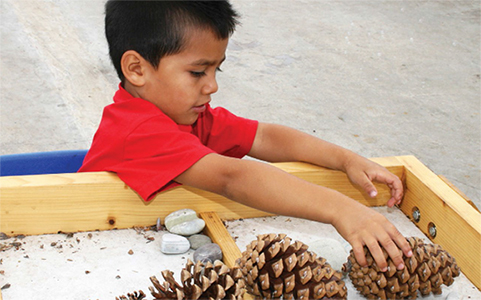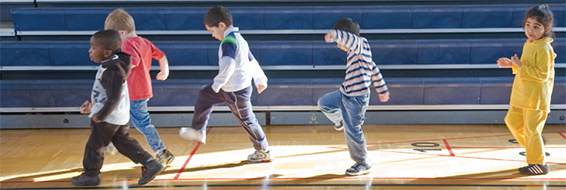Domain: Mathematics Development
Sub-Domain: Counting and Cardinality
Goal P-MATH 1. Child knows number names and the count sequence.
| Developmental Progression | Indicators | ||
|---|---|---|---|
| 36 to 48 Months | 48 to 60 Months | By 60 Months | |
| Says or signs some number words in sequence (up to 10), starting with one. Understands that counting words are separate words, such as "one," "two," "three" versus "onetwothree". | Says or signs more number words in sequence. |
| |
Goal P-MATH 2. Child recognizes the number of objects in a small set.
| Developmental Progression | Indicators | ||
|---|---|---|---|
| 36 to 48 Months | 48 to 60 Months | By 60 Months | |
| Develops an understanding of what whole numbers mean. Begins to recognize the number of small objects in groups without counting (referred to as "subitizing"). | Quickly recognizes the number of objects in a small set (referred to as "subitizing"). |
| |
Goal P-MATH 3. Child understands the relationship between numbers and quantities.
| Developmental Progression | Indicators | ||
|---|---|---|---|
| 36 to 48 Months | 48 to 60 Months | By 60 Months | |
| Begins to coordinate verbal counting with objects by pointing to or moving objects for small groups of objects laid in a line (referred to as one-to-one correspondence). Begins to understand that the last number represents how many objects are in a group (referred to as "cardinality"). | Understands that number words refer to quantity. May point to or move objects while counting objects to 10 and beyond (one-to-one correspondence). Understands that the last number represents how many objects are in a group (cardinality). |
| |
Goal P-MATH 4. Child compares numbers.
| Developmental Progression | Indicators | ||
|---|---|---|---|
| 36 to 48 Months | 48 to 60 Months | By 60 Months | |
| Begins to accurately count and compare objects that are about the same size and are in small groups with adult assistance, such as counts a pile of two blocks and a pile of four, and determines whether the piles have the same or different numbers of blocks. Identifies the first and second objects in a sequence. | Counts to determine and compare number amounts even when the larger group's objects are smaller in size, such as buttons, compared with the smaller group's objects that are larger in size, such as markers. Uses numbers related to order or position. |
| |
Goal P-MATH 5. Child associates a quantity with written numerals up to 5 and begins to write numbers.
| Developmental Progression | Indicators | ||
|---|---|---|---|
| 36 to 48 Months | 48 to 60 Months | By 60 Months | |
| Begins to understand that a written numeral represents a quantity and may draw objects or use informal symbols to represent numbers. | Understands that written numbers represent quantities of objects, and uses information symbols, such as a tally, to represent numerals. With adult support, writes some numerals up to 10. |
| |
 Preschoolers develop mathematical knowledge as they interact with materials.
Preschoolers develop mathematical knowledge as they interact with materials.Sub-Domain: Operations and Algebraic Thinking
Goal P-MATH 6. Child understands addition as adding to and understands subtraction as taking away from.
| Developmental Progression | Indicators | ||
|---|---|---|---|
| 36 to 48 Months | 48 to 60 Months | By 60 Months | |
| Begins to add and subtract very small collections of objects with adult support. For example, the teacher says, "You have three grapes and get one more. How many in all?" Child counts out three, then counts out one more, then counts all four: "One, two, three, four. I have four!" | Solves addition problems by joining objects together and subtraction problems by separating, using manipulatives and fingers to represent objects. |
| |
Goal P-MATH 7. Child understands simple patterns.
| Developmental Progression | Indicators | ||
|---|---|---|---|
| 36 to 48 Months | 48 to 60 Months | By 60 Months | |
| Recognizes a simple pattern, and with adult assistance, fills in the missing element of a pattern, such as boy, girl, boy, girl, ___, girl. Duplicates and extends ABABAB patterns. | Creates, identifies, extends, and duplicates simple repeating patterns in different forms, such as with objects, numbers, sounds, and movements. |
| |
Sub-Domain: Measurement
Goal P-MATH 8. Child measures objects by their various attributes using standard and non-standard measurement. Uses differences in attributes to make comparisons.
| Developmental Progression | Indicators | ||
|---|---|---|---|
| 36 to 48 Months | 48 to 60 Months | By 60 Months | |
| With adult support, begins to understand that attributes can be compared, such as one child can be taller than another child. | With some adult support, uses measurable attributes to make comparisons, such as identifies objects as the same/different and more/less. |
| |
Sub-Domain: Geometry and Spatial Sense
Goal P-MATH 9. Child identifies, describes, compares, and composes shapes.
| Developmental Progression | Indicators | ||
|---|---|---|---|
| 36 to 48 Months | 48 to 60 Months | By 60 Months | |
| Recognizes and names typical circle, square, and sometimes a triangle. With adult support, matches some shapes that are different sizes and orientations. | Recognizes and compares a greater number of shapes of different sizes and orientations. Begins to identify sides and angles as distinct parts of shapes. |
| |
Goal P-MATH 10. Child explores the positions of objects in space.
| Developmental Progression | Indicators | ||
|---|---|---|---|
| 36 to 48 Months | 48 to 60 Months | By 60 Months | |
| Begins to understand spatial vocabulary. With adult support, follows directions involving their own position in space, such as "Stand up and stretch your arms to the sky." | Increasingly understands spatial vocabulary. Follows directions involving their own position in space, such as "Move to the front of the line." |
| |
 In the context of play, preschoolers learn about the position of their own bodies in space.
In the context of play, preschoolers learn about the position of their own bodies in space.Last Updated: May 21, 2024
